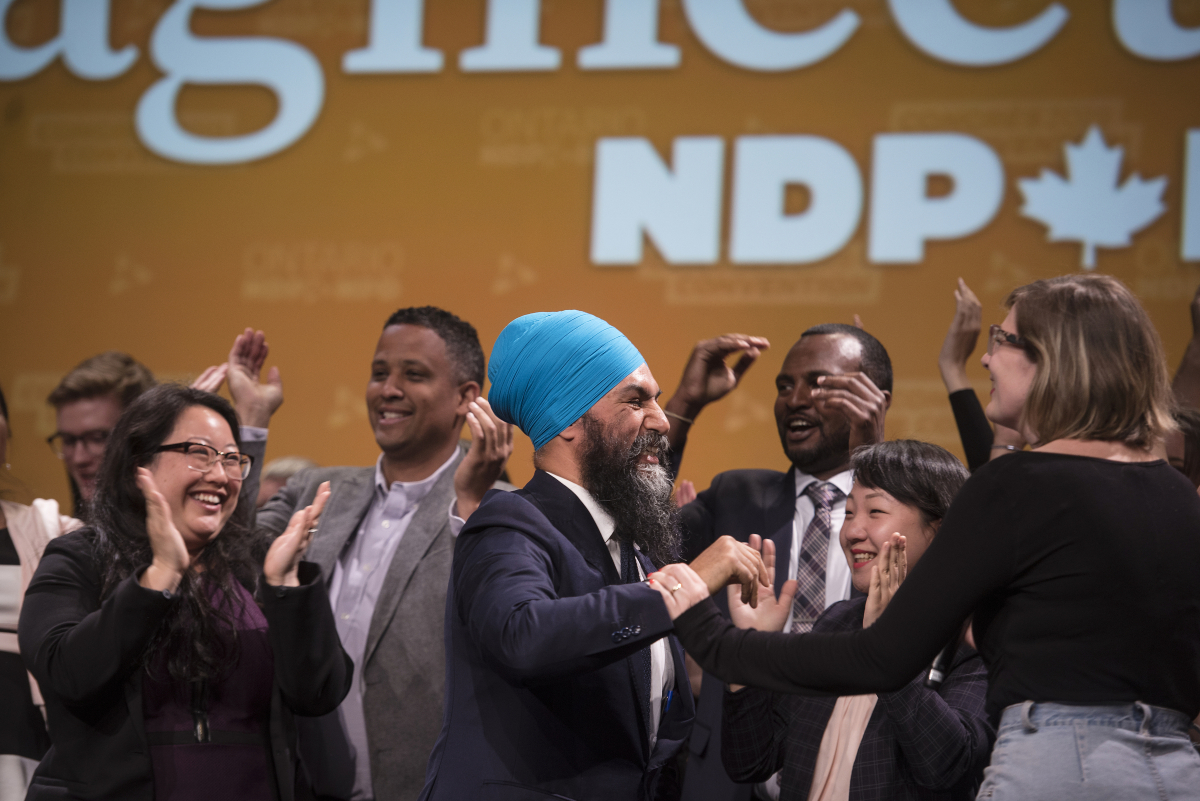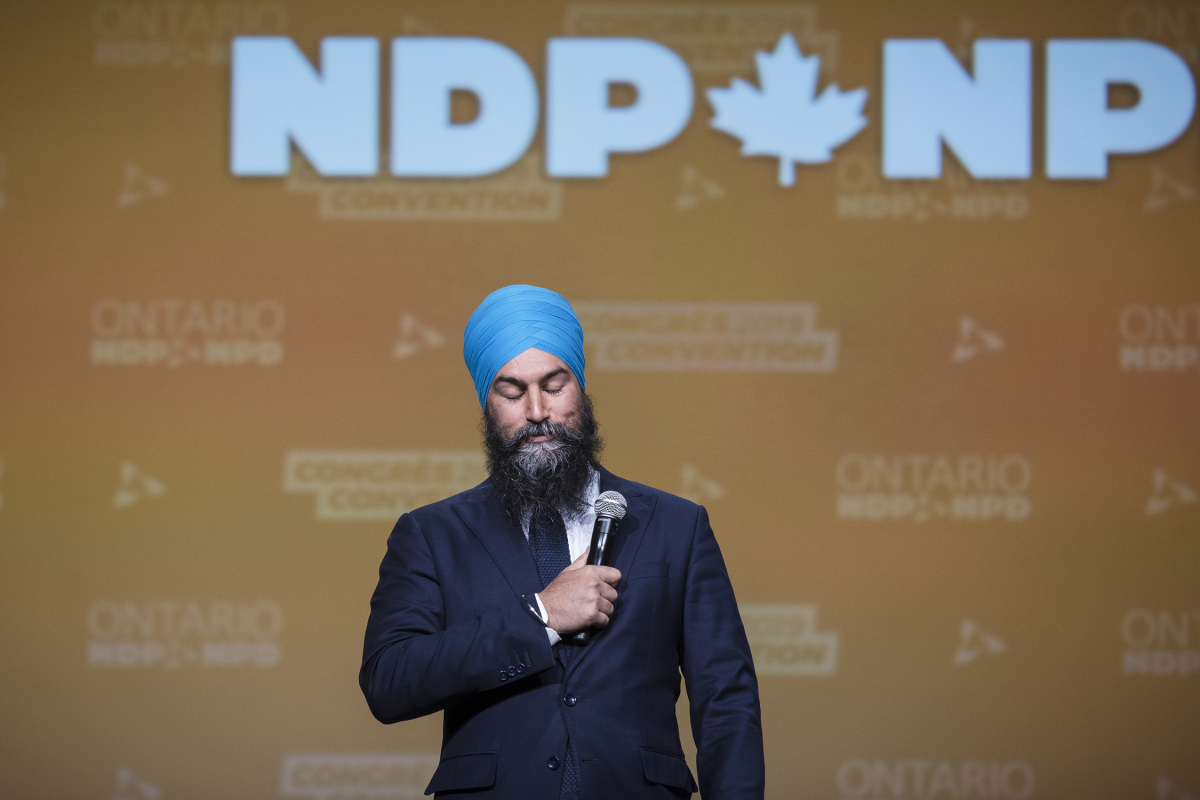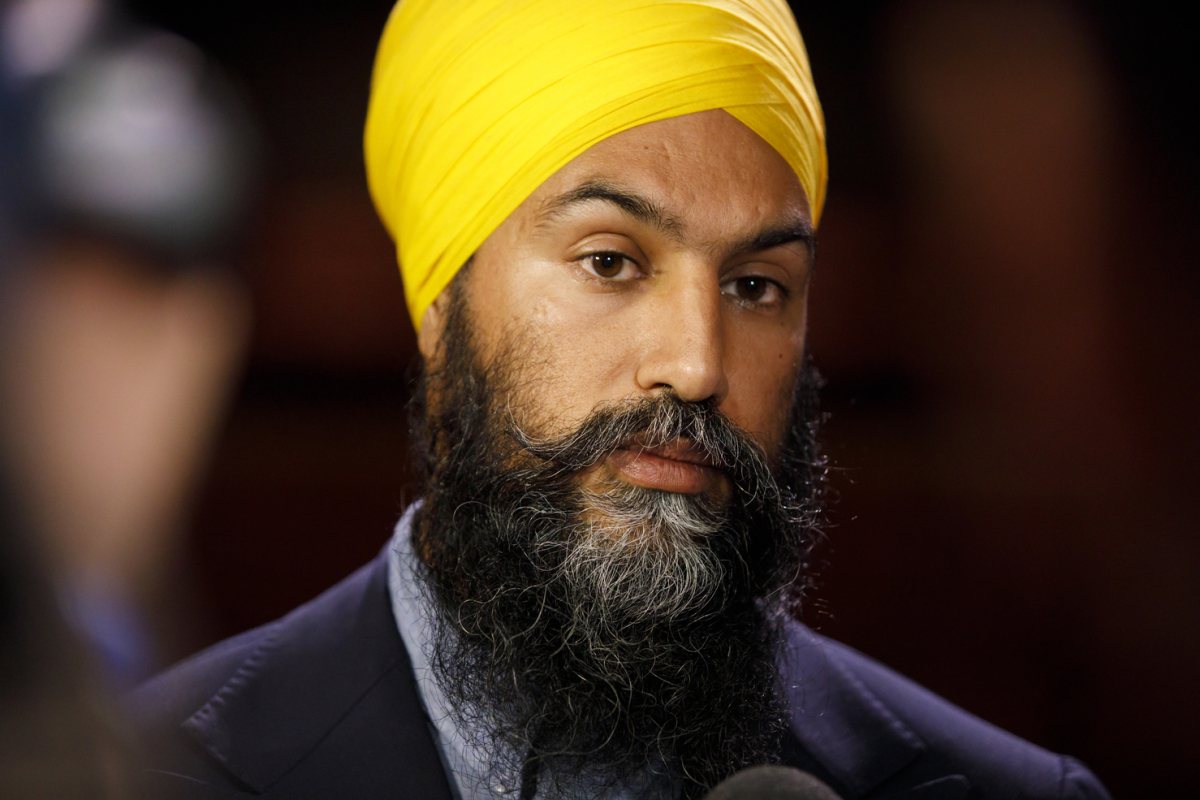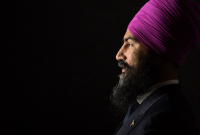Support strong Canadian climate journalism for 2025
“I’m a Jagmeet Singh New Democrat.”
Matthew Green casually throws out the phrase as if anyone familiar with Canadian politics would immediately understand.
But what the rookie NDP candidate in the working-class riding of Hamilton Centre in Ontario encapsulates is a specific emergence in Canadian politics: a young, energetic activist, grassroots but not necessarily rank-and-file, someone willing to fight corporate and other traditional forms of power.
He’s also someone more representative of Canada’s demographic reality in 2019, a complicated notion in an election littered with racial tensions that the NDP’s leader, Singh, has been expected to spend a disproportionate amount of time wrestling with.
Throughout the campaign, Singh, a practising Sikh, has been put in “a very neat and tidy category as a historical figure” for being the first racialized candidate at the top of the ballot box, Green said.
In some cases, such as his thoughtful response to the images of Justin Trudeau in brownface and blackface, Singh has been able to turn the extra attention to his advantage.
In others, such as the insidious dog-whistle racism of the People’s Party of Canada’s Maxime Bernier, it has been harder to grasp, although he did land a punch on the former Conservative minister during an Oct. 7 televised debate, when he accused Bernier of inciting racial hatred.
The English debate also saw rival leaders awkwardly congratulating Singh for his handling of casual racism, such as when a man told the NDP leader that removing his turban would be “more Canadian” (“I think Canadians look like all sorts of people,” Singh replied to the man, in front of television cameras, at a market in Montreal ahead of a televised French-language debate that evening).
Now, close to the end of a campaign in which none of the leaders, except Singh, has made a concerted effort to reckon with, or even acknowledge, systemic racism, there remains evidence of an underlying, largely unaddressed unease within the electorate, which is split, roughly equally, into those who support high levels of immigration, those who oppose it and those who support it with conditions.
Within this polarization, the NDP, as a progressive party, has tried to sell itself as a viable third option in handling all these issues — neither “Mr. Delay or Mr. Deny” on climate change, as Singh referred to Trudeau and Conservative Leader Andrew Scheer, respectively, during the Oct. 7 debate.
The NDP is doing all this with its largest-ever cohort of non-white candidates seeking federal office, with 22 Indigenous people and 20 black people campaigning in this election, many of whom, much like Green, see themselves as part of a fresh wave of New Democrats: blind to race and eager to take on the structural forces that perpetuate inequality.

But questions about race and representation have been at once in your face and submerged in this election. And only the NDP has sought to connect the subject to Canada’s broader socio-economic problems: pledging to end fossil fuel subsidies, promising free dental care and expanded pharmacare and raising taxes on the wealthy.
Nisha Nath, an assistant professor of equity studies at Athabasca University, said that all this is disappointing, but not surprising.
“I’m not inclined to say that election campaigns offer any real opportunities to grapple with structural oppression like racism,” she said. “It’s very difficult to see how a process that is meant to legitimize colonial forms of governance can lead to any sort of real grappling or reckoning.”
“Be that as it may,” she added, “a more honest wrestling with race and racism would likely make the connections between policy, racialized impact and structural oppression.”
According to Nath and several other Canadian political scientists interviewed by National Observer, such wrestling could include, for example, acknowledging that settler treatment of Indigenous people has amounted to genocide and that racialized individuals were disenfranchised as recently as 1947.
“Racism is baked into the origins of the Canadian state,” said Melanee Thomas, an associate professor of political science at the University of Calgary. “We are bad at talking about how integral it is to our political processes.”
She pointed out two examples: the section of the Oct. 7 debate set aside for discussion of Indigenous issues, which quickly turned to pipelines — a subject that presented the parties with a better opportunity of setting themselves apart — and the lack of attention paid to the government’s legal challenge to a human-rights commission’s order of compensation to children taken from their families.
“We’re really proud of the fact that we ran a team that reflects Canada. That’s something we’re really proud of,” Jagmeet Singh told National Observer in a brief interview outside a Toronto restaurant. “I think a lot of people face barriers in their life because of who they are, who they love, the colour of their skin, their religion, their beliefs. I hope people see me as someone who understands what that’s like and who is trying to build a country with no barriers.”
“We’re trying,” Singh said when asked if the conversation about race was manifesting constructively this election. “And I’m honoured to be a part of it.”
A spokesperson for racialized people
People forget that in 1975, the main challenger to Ed Broadbent in the NDP leadership race was Rosemary Brown, the first black woman to take a seat in a provincial legislature and the first woman to run for leadership of a federal political party in Canadian political history.
The Jamaican-Canadian politician’s campaign slogan at the time was “Brown is Beautiful.”
“Change matters,” Broadbent, who led the party from 1975 to 1989, said in an interview. “And the degree matters.”
Broadbent reminisced about how Brown at the time “drew people in,” bringing women to the NDP but also racialized Canadians. She broke down barriers at an earlier time of divisive racial politics, Broadbent said, and facilitated the party’s “long-running attempt to build a caucus that resembles the nation as a whole.”
Some 45 years later, Broadbent is campaigning for the party’s — and the country’s — first racialized leader, who is doing what Brown did, on a larger stage and for a new generation of voters.
On Oct. 6, almost a month into the election campaign, Broadbent and Singh were at an Ottawa market, where the former NDP leader was “surprised” by the degree to which the public responded to his presence.
“What I expected was general Canadian politeness and some warmth and possibly one or two negative questions on policy. We got none of that,” Broadbent said. “Just strong interest in him from all these categories of people.”
“There’s an initial curiosity by white Canadians,” Broadbent said. “But what brings them in is the warmth of Jagmeet’s personality. It's not just that he’s brown in colour. It’s that he listens to people — all people.”
Racist reactionary violence and politics around the world has primed Canadians to want a spokesperson for racialized people, and inadvertently an ambassador for what Canadian multiculturalism looks like in today’s hyperpolarized era. While Singh may not have voluntarily signed up for it, it has become his task at hand.
Singh took his seat in the House of Commons the day after two mosques in Christchurch, New Zealand, were attacked by a white supremacist (the gunman cited the 2015 Quebec mosque shooting in his manifesto). His campaign exists in the shadow of Bill 21, a Quebec law that prevents public servants from wearing religious symbols, such as the turban, at work. And then, days into the campaign, he was confronted by pictures of the current prime minister in offensive dark makeup.
At every turn, Singh has had to clean up everyone’s “racial mess,” said Kiavash Najafi, a former NDP strategist.
Despite being placed in this box again and again, Singh has thrived, Najafi said, because “he hasn’t put on a mask” and shied away from these big questions. Instead, he has embraced “a call-in culture” that has invited Canadians to ask big questions about divisive matters and then think about change, broad and difficult as it may seem.
“You get the sense that he believes we can bring people back from the dark corners that they are in now,” Najafi said. “He innately trusts in the goodness of people.”
That kind of perspective has trickled down, Green said, to the current slate of candidates.
“His humility, his grace, his maturity. These are things of this moment, he's demanding this moment of extreme division, what I would call corporate takeover of the political discourse. And he's bringing it back to the people,” Green said, who himself made history when he became Hamilton’s first black city councillor last year before embarking on this federal run.
But while those close to the party, and its supporters, laud Singh’s calm and competent performance in the face of polarization, questions remain about whether it will translate to gains at the ballot box.
“Mr Singh has risen to a very difficult situation that is obviously structured by racism,” said Thomas, the University of Calgary professor.
“It's heartbreaking how important this was for some Canadians to see, Canadians of colour,” she said, referring to Singh’s response to Trudeau’s brownface. “I know how important it was for white Canadians to see this and I really don't think that we're getting the memo about the kind of truth we have to start talking about — what's going on in our country and what has always been going on in our country.”
Racial politics in a country of ‘conditional multiculturalists’
The fact is that, while race has been ever-present in the background of this election, it is an issue politicians typically avoid, calculating that there is not a lot of leverage there to win over undecided voters, but also because it is a delicate affair in a country as diverse as Canada.
“For many Canadians, white Canadians, this just isn't in their spectrum,” said Erin Tolley, an assistant professor of political science at the University of Toronto. “It's just not in their orbit, and they don't vote on the basis of these issues.”
Tolley and fellow U of T researcher Randy Besco argue in Does Everyone Cheer? The Politics of Immigration and Multiculturalism in Canada that as many as one-third of Canadians hold negative views about immigration and ethnic diversity while another third are what Tolley calls “conditional multiculturalists.”
“Even though we have this idea that Canadians are pro-multiculturalism, pro-immigration and pro-diversity, if you really look at the public-opinion data, there are a third of Canadians who are strongly against immigration and multiculturalism,” she said in a phone interview. “There's another third in favour, strongly in favour... and then there's this whole third in the middle that honestly can go either way. They can go back and forth and they can be swayed.
“They often say that they like immigration and multiculturalism, but it comes with conditions like ‘we like immigration, as long as immigrants integrate, or we like multiculturalism, as long as minorities adopt Canadian values,’” she said. “There's a lot of conditionality to Canadians’ acceptance, or tolerance sometimes, of immigration and diversity. And that, to me, is the problem.”

It is a problem being exacerbated by the rise of Bernier, whose People’s Party of Canada wants to cut immigration levels and do away with policies that protect cultural freedoms and recognize the contributions of diverse ethnic groups to Canadian society.
“The real problem is that, for a lot of Canadians, having equal rights for people to maintain their distinct cultural practices — that's just not something that they feel comfortable with,” Tolley said.
That issue has come to a head in Quebec with Bill 21. While Singh has taken a strong verbal stance against the law, which is currently being challenged in Quebec’s courts, he has stuck to a non-interventionist position on what Ottawa should do about it.
This is about electoral calculus, Tolley said.
“The NDP, especially in 2011, they garnered some of their support in Quebec from voters who sympathize with the Bloc Québécois,” she said, adding that many of them had negative feelings about visible religious symbols and are strenuously opposed to interference in Quebec’s affairs.“So if the NDP says it's going to intervene in a court case to overturn the ban of religious symbols, that party is going to be especially punished,” she said.
The NDP, which was trailing the Greens in polls earlier in the campaign, has made gains and, as of Oct. 15, were set to pick up 34 seats, according to the CBC’s aggregate of publicly available data. The Liberals were tracking to 135 and the Conservatives are at 132 (169 seats are needed to form a majority government).
The Bloc Québécois, which only runs seats in Quebec and presents Bill 21 as an issue of sovereignty, has also surged in recent polls and looks set to pick up a similar number of seats to the NDP.
The Liberals, who have left the door open to a possible intervention over Bill 21, are “making the same calculation as the NDP, but they draw on a different base,” Tolley said. “The Liberals tend to attract federalist Quebeckers: these are voters who aren't going to be turned off by some amount of federal interference or federal pressure. The Liberals can afford to leave the door open to a court challenge in a way that the NDP has less latitude to do.”
The Conservatives, meanwhile, don’t lose much by saying they won’t intervene, she said, as a significant block of their support comes from seats in provinces such as Alberta and Saskatchewan, where voters are less concerned about the ban.
Thomas, from the University of Calgary, said she does not believe a re-elected Trudeau Liberal government would actually intervene in the case, because they would lose.
The issue came into sharp focus during the Oct. 7 debate, when Singh was randomly selected to answer a question on Bill 21 and at the end of the section, Trudeau turned to the NDP leader and asked, “So why not act on your convictions and leave the door open to challenging it?”
“It is really gross for a white man to be lecturing a person of colour about how best to stand up for people of colour,” Thomas said.
Imagine a real reckoning with racism
“Jagmeet Singh is a lawyer who has got 11 years of legislative experience as a deputy leader in the Ontario legislature,” Green said matter-of-factly. “Andrew Scheer was an insurance broker.”
The fact he attempts to make is that Singh has often been disregarded, forced to carve out a space for himself as a leader in a democratic system that tries to be representative of the community that it reflects, but has failed time and time again. Now, Green and company — taking their cues from Singh — try to talk about the big issues through a diverse lens: what does climate change mean for the Canadian working class in 2019? How is housing disrupting immigrant communities? And what does health care look like for the lowest-income communities?
The NDP candidates on the ballot box this year “had to persevere” Green said. “These are people who are deeply connected and committed to their communities. They have the courage to speak clearly around difficult values and conversations we’re having across the country.”
Toronto NDP candidate Diana Yoon said she never imagined running for an election with such a diverse slate of candidates. “We strongly believe in a vision for a better country and better community, and we understand we need to do better to bridge the gap between grassroots politics and electoral politics,” she said in an interview.
Yoon said that at “a time of intersecting crises” the NDP is doing the obvious, like “putting reconciliation at the forefront of everything,” and the things that are unheard of, like a super-wealth tax. But it's time, she said: “Why don't we have governments and leaders that put people first as opposed to corporate power?”
Perhaps Singh’s role in moulding these perspectives was most evident when he spent a couple of hours chatting and taking photographs with students at Ryerson University in downtown Toronto on Oct. 8.
Meryam Khan, a 19-year-old biomed student who saw the flock of students with Singh but did not participate in the exchange, said she saw Singh’s candidacy as a breath of fresh air, as a candidate who was finally speaking to and on behalf of those who are not white.
“He’s basically standing up for everyone in Canada, and that’s something that should have been done a long time ago,” she said.
Her friend, 19-year-old public-health student Noor Hussain, agreed, and said that for many of the people she has spoken to about the election, it is Singh’s racialized identity that is prompting them to vote for him.
“They are actually voting for him just because he's a person of colour... but not so much that he's part of the NDP,” she said.
The distinction is a fine one. With so much attention on race, little has been said constructively of what this will look like come Oct. 21 and beyond. What does it mean for policy? For politics? For the Canadian people?
Is Singh’s “presence in this race” — a phrase he has used countless times himself — enough to push Canada’s multiculturalism agenda forward in a progressive and inclusive way?
“It’s pretty easy to look to Maxime Bernier and Andrew Scheer and see how the politics of race and intolerance are at play, and of course to Trudeau’s blackface,” Nath said.
But that does not equate to a reckoning with race, she said.
“If the leaders were to engage in policy discussions about racialized health inequities, or the precarity of labour and citizenship, the racialized impact of the Safe Third Country Agreement or violations of UNDRIP in the pursuit of pipelines, that would certainly mark a shift,” she said. “Is that going to happen during an election campaign? No.”
Whether a constructive reckoning with race continues afterward, with a racialized leader in government or opposition, also remains to be seen.








Comments
I continue to be amazed that nowhere in any discussion of immigration and Canadians’ attitudes toward it, is there any acknowledgment of government’s calculated use of immigration policy to suppress domestic wages. It’s part of the neoliberal toolbox, and it’s only our relentlessly corporate media that keeps this from ever entering the discussion.
The feds are doing it right now, as we prepare to vote. With the Harperites’ egregious overuse of the TFW program, the Liberals have had to be creative. So, they’ve quadrupled the number of 3-year work visas, and doubled the number of international student visas.
When immigrants are used this way, it inevitably creates resentment, pitting people against each other, and that’s not an accident. Neoliberals are big fans of the “designated enemy,” against whom the populace is whipped up at intervals.
The challenge for anyone hoping to find a way out of the morass is to identify the mechanism and how it works, without scapegoating the people caught in it.